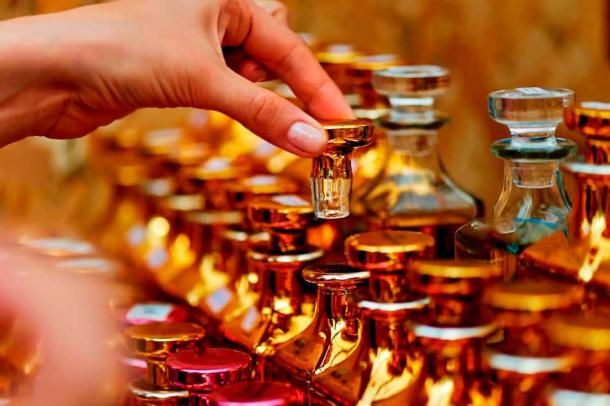Perfumers in Turkey Replicate a 3,200-Year-Old Mesopotamian Perfume
A group of perfumers have come together to recreate an ancient Mesopotamian perfume formula. Originally made 3,200 years ago, they have replicated a fragrance from what has come to be known as the cradle of civilization. The perfume uses plants endemic to the Mesopotamian region and is being exhibited at the historic Church of St. George in southeastern Turkey’s Diyarbakır.
This was the second Mesopotamian Fragrances Exhibition to take place, reported Hurriyet Daily News. The first was held at Şanlıurfa earlier this year. Diyarbakır was one of few places in ancient times where a scent culture prospered. In fact, it was a crucial stop on what came to be the ancient scent route.
- Cleopatra’s Perfume Recreated – A Scent That Once Masked The Odor Of Sour Donkey Milk!
- AI Bot Will Sniff Out Historic Smells to Recreate Ancient Smellscapes
According to the Daily Sabah, Diyarbakır’s Governor Ali Ihsan Su, perfumers and scent specialists participated in the program. Replicas of perfume bottles from thousands of years ago were displayed at the venue and visitors were even presented with a sample of this ancient Mesopotamian perfume.

Not only did they replicate ancient Mesopotamian perfume, but the perfume bottles as well. (gal2007 / Adobe Stock)
Why Nisaba? Naming an Ancient Mesopotamian Perfume
Created from plants native to the Upper Mesopotamian region, the perfume has been called Nisaba after the Mesopotamian goddess of grain and writing. Nisaba is one of the oldest Sumerian goddesses whose name figures in writing. Although she conceded her place after the Old Babylonian period to Nabu, a new scribe god, her name continued to appear in ancient Mesopotamian written records.
Aromatherapist and fragrance specialist Bihter Türkan Ergül is one of the chief people associated with the project. “We gave it a new name: Mesopotamian Nisaba, which is the goddess of grain, land and knowledge,” she explained when discussing the name of the Mesopotamian perfume which was creating using endemic plants from the region. “We gave it this name because the grain comes from the soil,” reported the Hurriyet Daily News.

Depiction of the goddess Nisaba at the Pergamon Museum in Germany. (Wolfgang Sauber / CC BY-SA 1.0)
Diyarbakir and the Ancient Scent Trade
Diyarbakir is located in the Mesopotamian basin and was home to many ancient civilizations such as the Sumerian, Assyrian, Babylonian and Hittite. It was a primary center for the production of fragrances and was a vital stop for perfume traders on the ancient scent routes which connected India and Arabia to Mesopotamia, Syria, Israel, Egypt, Greece and Rome.
These ancient Mesopotamian perfumes were bottled in special glass and ceramic containers. On display in the exhibition were replicas of scent bottles and containers discovered during excavations. These were originally unearthed at the 3,000-year-old Zerzevan Castle which is located between Diyarbakir and Mardin and was a military settlement under the Roman Empire. Associate Professor Cenker Atila, an archaeologist from Sivas Cumhuriyet University and an expert on ancient ceramics, glass works, and perfume oversaw the production of these replicas.

The project recreated an ancient Mesopotamian perfume. (Minerva Studio / Adobe Stock)
Modern Recreation of an Ancient Fragrance
The project has involved a lot of research on the precise ancient processes used for scent extraction, which were then adapted to laboratory techniques. Equally, identifying the plants from which the Mesopotamian perfume was produced was no easy task. “We researched the scent culture, specifically the areas where they were produced and used, in the company of our experts,” explained Ergül about the long painstaking process in the Daily Sabah. “We know that these plants grow in Mesopotamian lands, yet we cannot be sure they are the same.”
- Napoleon's Love of Cologne May Be What Killed Him, Says UK Biochemist
- 3,200-Year-Old Mesopotamian Perfume Recreated from Ancient Text
“We tried to adopt old traditions into our age,” she highlighted about the process of producing the Mesopotamian perfume. “Now they will be made both in Europe and other countries. The fragrance born in our lands will continue to fill the world with the pride it deserves.”
Recreating the perfume bottles was another aspect the team had to take into account. The archaeologist Cenker Atila described the process of how they copied originals which are on exhibit around the world. “We made exact replicas of them and opened an exhibition focused on Mesopotamia and Anatolia,” he explained.
“In the future, by analyzing the data discovered in Izmir's Pergamon, Zerzevan Castle, we will attempt to create the same perfumes made at that time, both to provide commercial income to the people of the region and to attract tourists,” concluded the archaeologist.
The project hopes to begin commercial production of Nisaba soon, with more perfumes to follow in the future. “These fragrances will be promoted on International Women's Day, and will provide an important contribution to employment,” enthused Ergül. Governor Su also announced plans to begin large-scale production of the Mesopotamian perfume in the near future.
Top image: The Turkey-based project has brought the smells of ancient Mesopotamian perfume back to life. Source: Marc Da Matisse / Adobe Stock
By Sahir Pandey
References
Daily Sabah. 2022. “Ancient fragrance made from Mesopotamian plants to be produced” in Daily Sabah. Available at: https://www.dailysabah.com/arts/ancient-fragrance-made-from-mesopotamian-plants-to-be-produced/news.
Falde, N. 2022. “3,200-Year-Old Mesopotamian Perfume Recreated from Ancient Text” in Ancient Origins. Available at: https://www.ancient-origins.net/news-history-archaeology/mesopotamian-perfume-0017057.
Hurriyet Daily News. 2022. “Perfume of Mesopotamian plants to be produced” in Hurriyet Daily News. Available at: https://www.hurriyetdailynews.com/perfume-of-mesopotamian-plants-to-be-produced-179422.



















